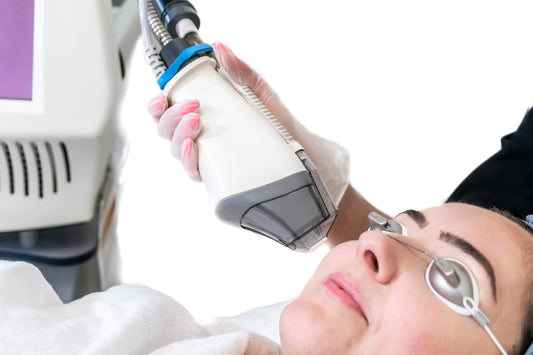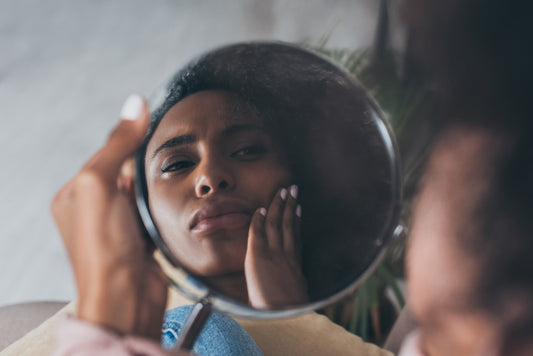Hair loss is often considered a uniquely male problem, but studies show that it affects about 40% of women by age 501and 55% of women by age 70.2 Though the numbers are slightly higher for men, the experience is universally frustrating.3 And the stress it brings on can make matters worse, as stress is known to exacerbate symptoms.
Driven by a number of factors, from genetics to hormonal changes, hair loss doesn’t always look the same in men and women, but there are some strategies that can help both.
Read on to find out how hair loss in men compares to hair loss in women and how to prevent thinning through medication, supplements, serums, and lifestyle.
Male and Female Pattern Hair Loss
Also known as alopecia, male and female pattern hair loss refers to a progressive, nonscarring form of hair loss, which can occur as early as puberty.4 Thinning of hair and loss of terminal hairs results in a decrease in hair density, which generally progresses slowly over the years in predictable patterns. The scalp typically remains healthy without associated symptoms.
There are a number of genetic and environmental factors that likely play a role in causing male and female pattern hair loss, but high levels of androgens, such as dihydrotestosterone (DHT), are largely to blame. DHT, which is a derivative of testosterone, can shrink hair follicles in men and women when levels are too high. This causes hair to grow out thinner and fall out faster.5 This hormone can also make it more difficult for your follicles to grow new hairs once old hairs have fallen out. Normal aging can cause a fluctuation in this hormone as well as other imbalances such as a decrease in estrogen seen in women during menopause.
While hormones play a large role in hair loss, genetics, aging, and lifestyle can also contribute. In fact, researchers have also found a connection between variations of the AR gene and increased activity in the androgen receptors inside hair follicles in men and women.6 And keratin declines in both men and women as they get older.7
Physical Signs
While men’s hair loss is characterized by a receding hairline, female hair loss typically starts with thinning on the top and crown of the scalp. Though the physical signs of hair loss may differ between men and women, they do not require different ingredients to promote hair growth. The same formula could work for both.
Here’s how to distinguish male and female hair loss:
Men
Physical signs of male pattern hair loss include:
- Gradual thinning on the top and front of the head
- Receding hairline forms an M shape
- Slowed hair growth
- Hair shedding throughout the day
- Loose hairs on your pillow or hairbrush
- Circular or patchy bald spots
Women
Physical signs of female pattern hair loss include:
- Thinning mainly on the top and crown of the scalp, which usually starts with a widening through the center hair part
- Hair shedding throughout the day
- Seeing your scalp through hair
- Hair breakage
- Noticeable patches of thinning or missing hair
UnTangled Essentials Kit
• Engineered to work in tandem
• Visibly fuller hair in 90 days
How To Prevent & Improve Hair Thinning
If hair loss is caused by a scalp infection or medication, clearing up the infection or switching medication can help stop thinning and promote growth. But if your hair loss is the result of genetics, hormonal imbalances, or environmental factors, there are a number of strategies that can help you prevent further hair loss and regain hair fullness.
One option for hair loss is medication. Minoxidil, the active ingredient in the product Rogaine, is one of the most common medicinal treatments. It works by prolonging the time spent in the growth phase of the hair cycle and by stimulating blood circulation. But the medicine is associated with a number of side effects, whether taken topically or orally. If taken topically, you may experience itching, burning, and skin irritation.8 Side effects of oral Minoxidil include a fast or irregular heartbeat, weight gain, bloating, flushing, and an increase in hair growth on other parts of the body.9 Another downside of Minoxidil is the shedding that often occurs with initial use. As the medication speeds up the resting phase of the hair cycle, sometimes users experience hair loss before extending the growth phase afterward.
For those who are unable or unwilling to try Minoxidil, Foundation Skincare’s Hair Serum offers an alternative approach to combating hair loss with a custom blend of herbs like saw palmetto extract, apple stem cell, and olive leaf extract. The serum is proven to stimulate hair stem cells to encourage new growth and prevent further hair loss. The ingredients also target the very source of hormonal hair loss by blocking the conversion of testosterone into DHT thanks to the herb saw palmetto. Studies show topical and oral supplements containing saw palmetto among patients with alopecia resulted in an improvement in overall hair quality (60%), increased hair density (83.3%), and stabilized disease progression (52%).10
When paired with the UnTangled Hair Supplement, which also includes saw palmetto in addition to other vitamins, minerals, herbs and acids, improvement can be seen in as little as 30 days. The UnTangled Hair Supplement revitalizes a stagnant hair growth cycle by increasing the production of keratin in follicles for visibly thicker, fuller hair. In fact, if you are already taking a product you like, including Minoxidl, adding the UnTangled supplement can enhance your results without causing any contraindications.
These hair loss products work best when taken at the first signs of thinning, but you can also support your efforts through lifestyle changes like eating extra protein, avoiding harsh hair treatments, stopping smoking, and managing your stress levels.
Other Reasons For Hair Loss
If hair loss is caused by a temporary situation like a cancer treatment, pregnancy, or stressful event, regrowth will likely recommence after these periods end. According to the American Academy of Dermatology, hair usually starts to regrow within months of finishing chemotherapy or radiation treatments and within six to nine months after giving birth or after a stressful experience.11
Some other potential causes of hair loss to consider include:
- Thyroid disease
- Alopecia areata (immune dysfunction)
- Scalp psoriasis
- Hair pulling
- Polycystic ovary syndrome (PCOS)
- Cardiovascular disease 12
- Certain hairstyles and hair treatments like cornrows, tight braids, hair extensions, and weaves
- Testosterone replacement therapy (TRT)
Whether you are a man or a woman, hair loss doesn’t have to be inevitable. Finding the approach that works for you, the earlier the better, can help you maintain the building blocks your body needs to slow down thinning and keep your hair the healthiest it can be.
Explore other ways to support hair care and skin care in the FS Journal.
References:
-
https://www.ncbi.nlm.nih.gov/pmc/articles/PMC4573453/
-
https://www.mayoclinic.org/diseases-conditions/hair-loss/expert-answers/preventing-hair-loss-in-women/faq-20452842
-
https://health.clevelandclinic.org/why-do-men-go-bald-and-is-there-anything-you-can-really-do-about-it/
-
https://consultqd.clevelandclinic.org/male-and-female-pattern-hair-loss-a-guide-to-clinical-presentations-and-diagnosis/
-
https://www.ncbi.nlm.nih.gov/pmc/articles/PMC4174066/
-
https://medlineplus.gov/genetics/condition/androgenetic-alopecia/#causes
-
https://onlinelibrary.wiley.com/doi/pdf/10.1111/j.1600-0625.2011.01301.x
-
https://www.mayoclinic.org/drugs-supplements/minoxidil-topical-route/side-effects/drg-20068750?p=1
-
https://www.mayoclinic.org/drugs-supplements/minoxidil-oral-route/side-effects/drg-20068757
-
https://pubmed.ncbi.nlm.nih.gov/33313047/
-
https://www.aad.org/public/diseases/hair-loss/causes/18-causes
-
https://pubmed.ncbi.nlm.nih.gov/30390206/





